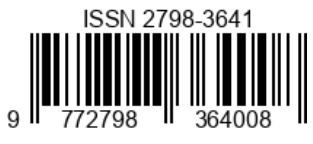ANALISA PENGARUH FOOD VLOGGER DAN DIGITAL MARKETING TERHADAP PURCHASE INTENTION YANG DIMEDIASI OLEH BRAND AWARENESS
Keywords:
Food Vlogger, Digital Marketing, Brand Awareness, Purchase Intention, CoffeeAbstract
As time goes by, especially in the era of globalization, the world has developed very rapidly, especially in the development of technology and the internet. One of the impacts of technological developments in the food and beverages industry, especially coffee shops which use internet platforms as a marketing base. Food vloggers have become an option for businesses to compete for consumers in the industry. This research uses quantitative methods and data collection techniques by distributing questionnaires using Google Form media and using non-probability sampling methods. The sample taken for this research was 110 respondents. Data were analyzed using structured equation modeling-partial least squares (PLS-SEM) with SmartPLS3 software. The research results show that there is a positive influence between food vloggers on brand awareness, food vloggers on purchase intention, digital marketing on brand awareness and brand awareness on purchase intention. Meanwhile, digital marketing does not have a positive influence on purchase intention. Apart from that, the brand awareness variable does not mediate the relationship between food vloggers and purchase intention, but brand awareness indirectly mediates the relationship between digital marketing and purchase intention
References
Alwana, S., & Alshurideh, M. T. (2022). Relevance of digital marketing content and its effect on purchase intention. Journal of Digital Marketing Research, 10(1), 45-62.
Bakti, A. P., Nugraha, R., & Putra, D. S. (2020). Pengaruh digital marketing terhadap purchase intention dengan brand awareness sebagai variabel mediasi pada industri makanan dan minuman. Jurnal Manajemen Pemasaran, 14(1), 25-38.
Barreda, A. A., Bilgihan, A., Nusair, K., & Okumus, F. (2015). Generating brand awareness in online social networks. Journal of Hospitality and Tourism Technology, 6(1), 48-62. https://doi.org/10.1108/JHTT-09-2014-0057
Belch, G. E. (2015). Advertising and promotion: An integrated marketing communications perspective (10th ed.). McGraw-Hill Education.
Bilgin, Y. (2018). The effect of social media marketing activities on brand awareness, brand image, and brand loyalty. Business & Management Studies: An International Journal, 6(1), 128-148.
Briliana, V., Santoso, L. I., & Utomo, W. (2020). The influence of influencer credibility on brand awareness in the culinary industry. Jurnal Komunikasi dan Pemasaran, 8(2), 123-140.
Chaffey, D., & Chadwick, F. E. (2019). Digital marketing: Strategy, implementation, and practice (7th ed.). Pearson.
Dash, G., Kiefer, K., & Paul, J. (2021). Digital marketing effectiveness and purchase intention: The role of content relevance and consumer trust. International Journal of Consumer Studies, 45(4), 890-907. https://doi.org/10.1111/ijcs.12678
De Veirman, M., Cauberghe, V., & Hudders, L. (2017). Marketing through Instagram influencers: The impact of number of followers and product divergence on brand attitude. International Journal of Advertising, 36(5), 798-828. https://doi.org/10.1080/02650487.2017.1348035
Djafarova, E., & Rushworth, C. (2017). Exploring the credibility of online celebrities' Instagram profiles in influencing the purchase decisions of young female users. Computers in Human Behavior, 68, 1-7. https://doi.org/10.1016/j.chb.2016.11.009
Etikan, I., Musa, S. A., & Alkassim, R. S. (2016). Comparison of convenience sampling and purposive sampling. American Journal of Theoretical and Applied Statistics, 5(1), 1-4. https://doi.org/10.11648/j.ajtas.20160501.11
Finne, Å., & Grönroos, C. (2017). Communication-in-use: Customer-integrated marketing communication. European Journal of Marketing, 51(3), 445-463. https://doi.org/10.1108/EJM-08-2015-0593
Freberg, K. (2021). Social media for strategic communication: Creative strategies and research-based applications (2nd ed.). SAGE Publications.
Hair, J. F., Black, W. C., Babin, B. J., & Anderson, R. E. (2017). Multivariate data analysis (8th ed.). Pearson.
Hendrayati, H., & Puspita, M. (2018). Pengaruh kepercayaan terhadap niat beli pada pemasaran berbasis influencer. Jurnal Ekonomi dan Bisnis, 12(4), 45-60.
Ihzaturrahma, R. M., & Kusumawati, A. (2021). Pengaruh brand awareness terhadap purchase intention melalui perceived value pada produk makanan cepat saji. Jurnal Manajemen Pemasaran, 13(2), 98-112.
Kim, J. (2017). The effect of influencer marketing on brand trust and purchase intention in social media environments. Journal of Marketing Research, 21(3), 58-75.
Kotler, P. (2018). Marketing 4.0: Moving from traditional to digital. Wiley.
Kotler, P. (2019). Marketing management (15th ed.). Pearson Education.
Kotler, P., & Keller, K. L. (2016). Marketing management (15th ed.). Pearson Education.
Masuda, T., Sugiyama, K., & Haruto, N. (2022). Influencer marketing strategies and consumer behavior: A case study on food vloggers. International Journal of Marketing, 18(2), 98-112.
Memon, M. A., Ting, H., Ramayah, T., Chuah, F., & Cheah, J.-H. (2021). Sample size guidelines for structural equation modeling: An updated approach. Journal of Applied Structural Equation Modeling, 5(2), 1-20.
Natasya, A. D., & Aulia, R. (2022). Strategi pemasaran berbasis influencer dalam meningkatkan brand recognition pada industri kopi. Jurnal Pemasaran Digital, 8(1), 45-57.
Nugraha, R., & Setyanto, E. P. (2018). Peran influencer dalam meningkatkan brand awareness pada industri kuliner di era digital. Jurnal Ekonomi dan Bisnis Digital, 10(1), 34-49.
Sekaran, U., & Bougie, R. (2016). Research methods for business: A skill-building approach (7th ed.). Wiley.
Subagio, T. A., Arifin, M., & Kurniawan, D. (2020). Pengaruh ulasan food vlogger terhadap keputusan pembelian konsumen. Jurnal Komunikasi Pemasaran, 12(3), 120-135.
Sugiyono. (2017). Metode penelitian kuantitatif, kualitatif, dan R&D. Alfabeta.
Wong, K. K. (2019). Partial least squares structural equation modeling (PLS-SEM) techniques using SmartPLS. Marketing Bulletin, 24(1), 1-32.
Xu, X., Ye, J., & Zhang, J. (2021). The impact of influencer marketing on purchase intention: The mediating role of trust and authenticity. Journal of Business Research, 128, 345-356. https://doi.org/10.1016/j.jbusres.2021.01.012
www.databoks.katadata.co.id/datapublish/2023/07/13/penduduk-indonesiatembus-278-juta- jiwa- hingga-pertengahan2023#:~:text=Menurut%20data%20Badan%20Pusat%20Statistik,sebanyak%2027 5%2C77%20juta%20jiwa. Diakses pada 4 Juli 2024.
www.dataindonesia.id/internet/detail/pengguna-internet-di-indonesia-sentuh- 212-juta-pada-2023. Diakses pada 20 Juni 2024.
www.researchgate.net/publication/362837927_Growth_Success_of_Social_Media_Marketing. Diakses pada 11 Juni 2024.
Zhao, X., Lynch, J. G., & Chen, Q. (2010). Reconsidering Baron and Kenny: Myths and truths about mediation analysis. Journal of Consumer Research, 37(2), 197-206. https://doi.org/10.1086/651257















